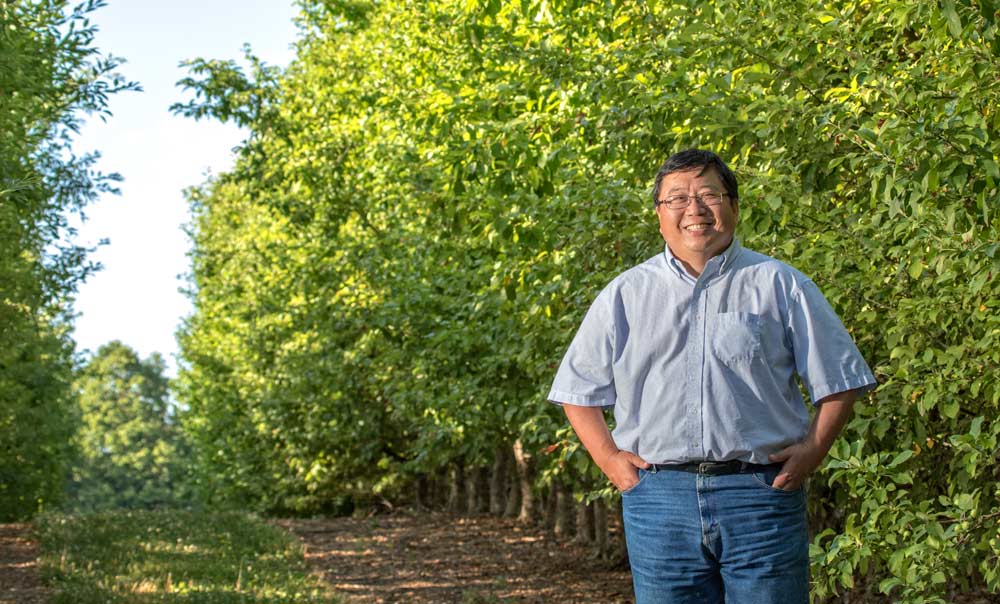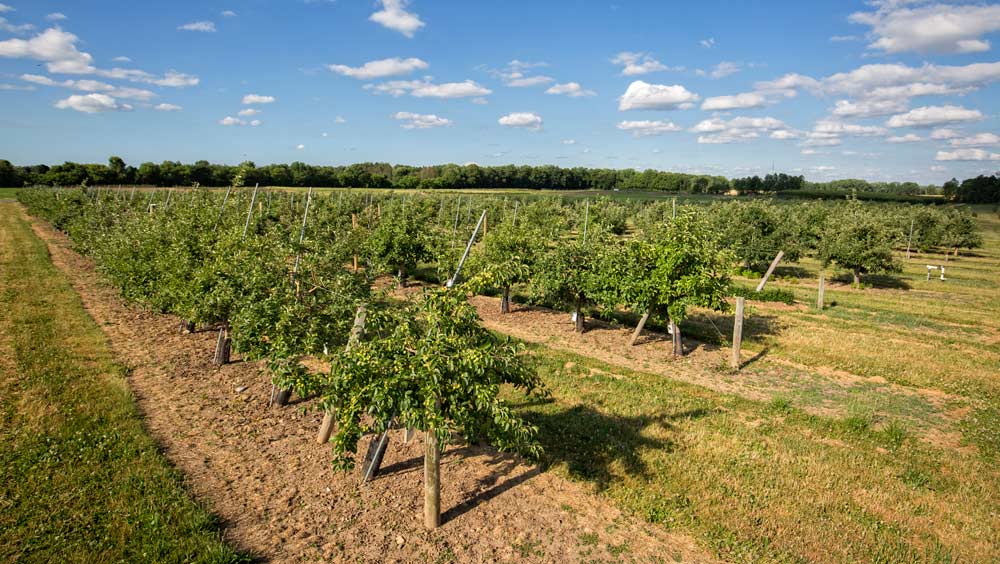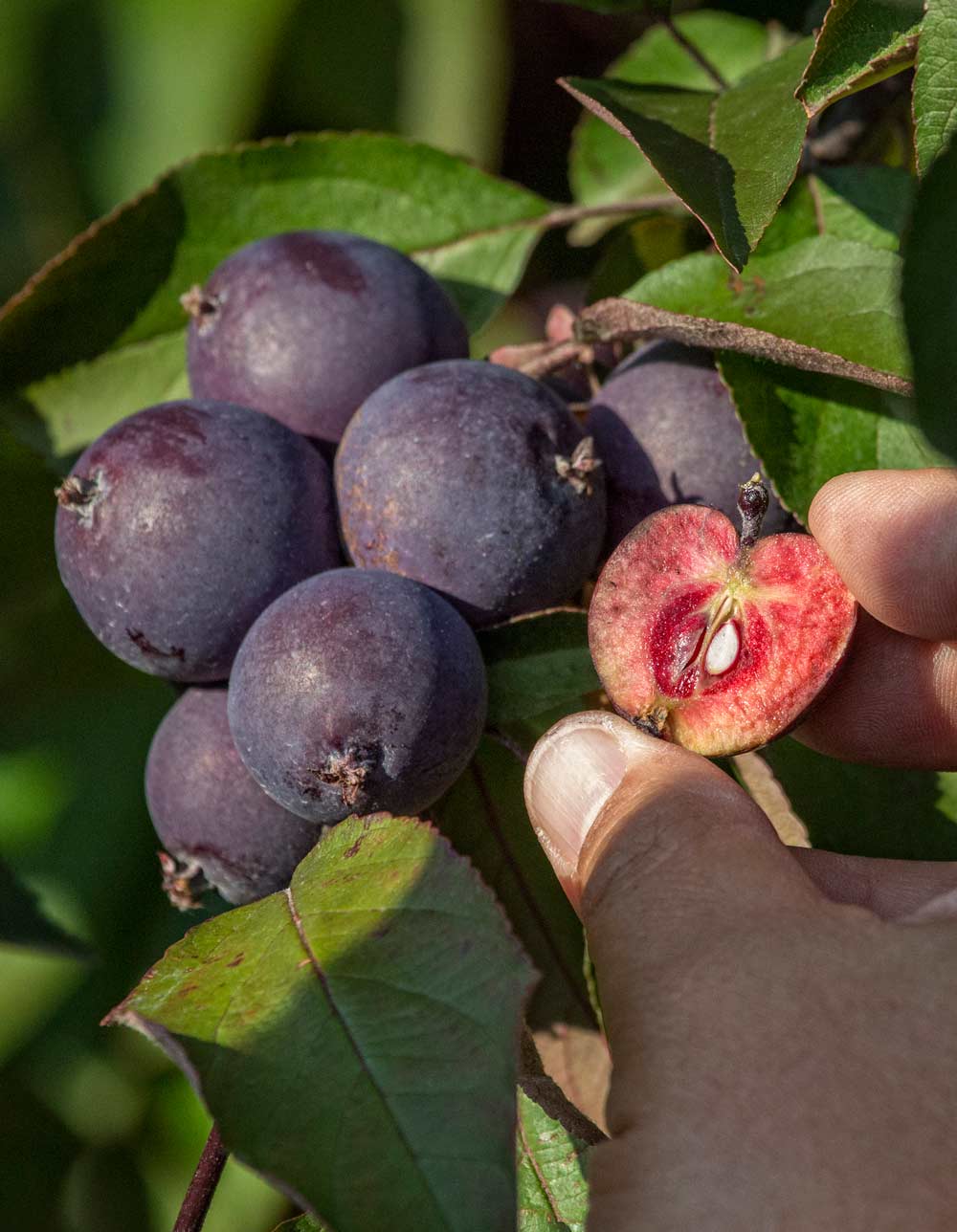
Thomas Chao, horticulturist and curator of the U.S. Department of Agriculture germplasm repository in Geneva, New York, stands among Malus Sieversii trees curated by researchers in 1995 in Kazakhstan. Chao oversees the care of thousands of pome varieties housed at the living museum. Malus Sieversii is believed to be the ancestor of commercial apples and continues to be a source of research for disease resistance and other desirable traits.
(TJ Mullinax/Good Fruit Grower)
Purple apples. Fruit trees that grow like a bush.
North American varieties that somehow seem like genetically older Asian species.
These are just a few of the head-scratching novelties among the thousands of apple varieties growing at the national Plant Genetics Resources Unit in Geneva, New York.
The germplasm repository, operated by the U.S. Department of Agriculture, fuels global research projects and fruit propagation across the United States, but also functions like a living museum in a sense.
Some of the progeny in the repository’s orchards genetically date back 40 million to 50 million years, said Thomas Chao, horticulturist and curator. “That’s a long time looking through the history,” he said.
Somewhere in that genetic history lay the answers to some old, old mysteries, too.
For example, the repository has descendants of three wild apple species native to North America that may be more ancient than any other wild species, even though Central Asia is generally regarded as the origin of the wild apple.

The first three rows of the repository hold what Thomas Chao believes are the most desirable trees for genetic diversity. He said the repository’s top priority is to protect varieties under threat in their home countries. “If we don’t preserve them, they could be lost forever. The industry is always going to face disease and environmental problems. On a long-term basis, many solutions for future issues will come from these wild species.” (TJ Mullinax/Good Fruit Grower)
The collection has nearly 6,000 apple varieties, as well as tart cherries and cold-hardy grapes.
It’s part of the department’s Agricultural Research Service National Plant Germplasm System, located in a network of facilities throughout the country.
Research resource
The Geneva collection aids in research a little closer to the here and now, as well.
Scientists come from around the world to take fruit, leaf and wood samples for their studies of different traits of apples.
Some examine the direction branches grow. Others seek different flesh colors. Still others want fruit with resistance to common diseases. The keys to those traits are hidden inside the genetic makeup of those thousands of species.

Thomas Chao splits open a Malus hybrid growing at the germplasm repository, showing its red flesh, a trait that has drawn interest from breeders and growers looking to add it to commercial apple varieties. Chao says the repository has the largest collection of Malus varieties outside of Central Asia. (TJ Mullinax/Good Fruit Grower)
The repository has aided several genetics projects for Kenong Xu, a Cornell University associate professor of plant genomics. Among them are studies of genes that control apple acidity, the direction of branch growth and storability.
In fact, he could not do his work at all without the repository, he said. “I rely on the repository a lot to conduct my research projects,” he said.
For his acidity projects, he visited the repository — conveniently located in the same town — to pick fruit from roughly 1,000 apple varieties so he could study their genetics.
In an early round, he identified a major gene that controls the acid level of apples and published his findings in 2012. He’s following up to study the diversity of that gene across varieties.
In the end, he expects breeders will use the genetic knowledge to weed out extremely low acid progeny, thereby increasing the efficiency of their progress by 25 percent.
Breeding is, by nature, a slow process of trial and error.
Without the repository, he would have to travel the entire world for enough fruit samples, making his research practically impossible.
The facility also supplies budwood to growers free of charge. Orchardists may choose up to 25 different accessions; they typically visit the online catalog and, after placing an order, will receive two sticks with about 10 buds each.
And the collection also functions as a safeguard for the world’s genetic diversity, providing a home for species native to areas where development and climate change may threaten their original habitats and all their hidden mysteries.
“We do know a lot, but still there’s a lot of questions we don’t know,” Chao said. •
– by Ross Courtney






Leave A Comment